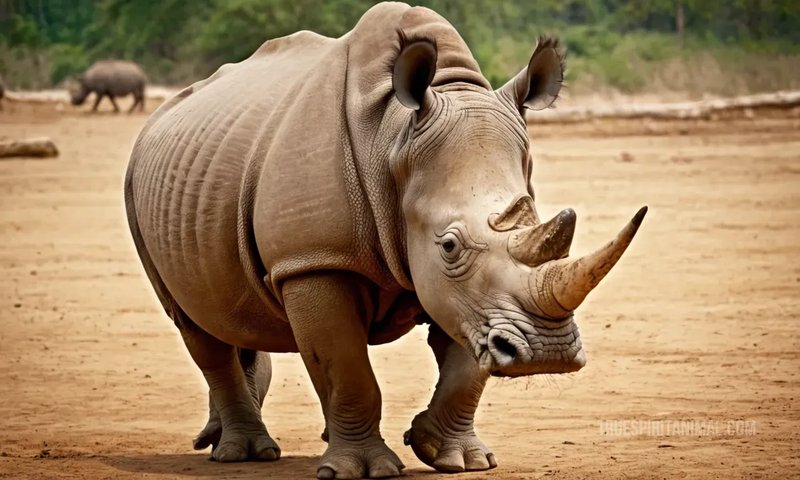
Imagine trying to solve a puzzle while surrounded by the dense jungles of Indonesia, where these rhinos call home. Picture them not just as lumbering giants, but as beings capable of some impressive mental feats. In this article, we’ll uncover their behaviors, cognitive skills, and how they adapt to their environment—much like how we learn to navigate our own lives.
Understanding Javan Rhinoceros Behavior
The Javan rhinoceros is a solitary creature, typically found in the dense rainforest of Ujung Kulon National Park in Indonesia. Their behavior is shaped by their environment and lifestyle. Unlike some other rhino species that can be more social, Javan rhinos prefer to roam alone.
One key aspect of their behavior is how they establish territories. Male Javan rhinos mark their territory with dung and urine, which not only communicates their presence to other rhinos but also signals their reproductive status. This territorial behavior is interesting because it shows that they have an understanding of their environment and how to navigate social interactions.
Further, Javan rhinos are crepuscular, meaning they are most active during dawn and dusk. This behavior likely helps them avoid the heat of the day and predators—showcasing an intelligent adaptation to their habitat. Honestly, it’s like they have their own rhythm, learning when it’s best to be out and about.
Cognitive Abilities: Problem-Solving Skills
You might be wondering if Javan rhinoceroses can solve problems. The truth is, they show signs of cognitive flexibility. For instance, they often need to navigate through dense vegetation to find food or water. This requires some level of problem-solving ability, as they must remember where water sources are located and how to access them.
When faced with obstacles like fallen trees or thick shrubs, these rhinos display a remarkable ability to find alternative routes. Imagine trying to get to your favorite park through an unfamiliar neighborhood; you’d have to mentally map out your options. Javan rhinos do something similar by using their memory and spatial awareness.
Additionally, researchers have observed that Javan rhinos interact with their environment in ways that imply curiosity. They often explore new areas, sniffing around for unfamiliar scents or sounds. This exploration is part of their learning process, helping them adapt to changes in their habitat.
Communication and Social Interactions
While Javan rhinos are solitary, they do have a form of communication—mainly through vocalizations and physical signs. Sounds like grunts or snorts can signal distress or attraction. It’s like having a voice that helps them express feelings or alert others to danger.
They also communicate through body language. For example, a rhino may approach another cautiously, signaling their intentions. This behavior shows that they can read social cues, which is a sign of higher cognitive function.
Interestingly, some studies suggest that Javan rhinoceroses can recognize each other by their unique vocalizations. Think about how you can tell your friends apart by their voices or laughing styles. This ability enhances their understanding of social dynamics, even within their solitary lifestyle.
Memory and Learning
Memory plays a crucial role in the intelligence of a Javan rhinoceros. These creatures must remember locations of essential resources like food and water, especially since their habitat can change due to environmental factors.
For example, if a water source dries up or a favorite feeding ground becomes scarce, a rhino needs to recall where other sources are located. This reliance on memory indicates a strong cognitive ability. Imagine moving to a new city—you’d need to remember where grocery stores, parks, and friends live, right? Javan rhinos do something similar in their need to survive.
Moreover, the ability to learn from previous experiences is another hallmark of their intelligence. If a Javan rhino encounters a predator, they learn from that experience, perhaps becoming more cautious in similar situations in the future. This level of learning can be crucial for their survival in the wild.
Conservation and Their Future
Understanding the intelligence of Javan rhinoceroses is vital, especially in the face of conservation efforts. With only about 80 individuals left, they’re critically endangered. Their cognitive abilities highlight the need for preserving their habitat, as these intelligent creatures rely on learning and adapting to thrive.
Conservationists are working tirelessly to protect these magnificent animals. They employ strategies that consider the cognitive needs of Javan rhinos, aiming to create environments where they can thrive. The better we understand their intelligence and behavior, the more effectively we can help them.
It’s a reminder that protecting the Javan rhinoceros isn’t just about saving a species—it’s about preserving a unique mind that has adapted to life’s challenges in a complex ecosystem.
The Javan rhinoceros is a remarkable creature with impressive cognitive abilities and complex behaviors. From their problem-solving skills to their unique communication methods, these animals teach us a lot about intelligence in the animal kingdom. As we learn more about them, we can appreciate their role in the ecosystem and the importance of their conservation.
So, next time you hear about a Javan rhino, think beyond the size and strength. Remember the thoughtful, intelligent creature navigating its home with a distinct personality and a set of skills that’s impressive in its own right. Protecting them is not just a duty; it’s an opportunity to safeguard a piece of nature’s incredible diversity.

